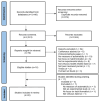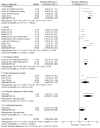Time to Form a Habit: A Systematic Review and Meta-Analysis of Health Behaviour Habit Formation and Its Determinants
- PMID: 39685110
- PMCID: PMC11641623
- DOI: 10.3390/healthcare12232488
Time to Form a Habit: A Systematic Review and Meta-Analysis of Health Behaviour Habit Formation and Its Determinants
Abstract
Background: Healthy lifestyles depend on forming crucial habits through the process of habit formation, emphasising the need to establish positive habits and break negative ones for lasting behaviour changes. This systematic review aims to explore the time required for developing health-related habits. Methods: Six databases (Scopus, PsychINFO, CINAHL, EMBASE, Medline and PubMed) were searched to identify experimental intervention studies assessing self-report habit or automaticity questionnaires (e.g., the self-report habit index (SRHI) or the self-report behavioural automaticity index (SRBAI)), or the duration to reach automaticity in health-related behaviours. Habit formation determinants were also evaluated. Meta-analysis was performed to assess the change in the SRHI or SRBAI habit scores between pre- and post-intervention, and the study quality was assessed using the PEDro scale. Results: A total of 20 studies involving 2601 participants (mean age range: 21.5-73.5 years) were included. Most studies had a high risk of bias rating (n = 11). Health behaviours included physical activity (n = 8), drinking water (n = 2), vitamin consumption (n = 1), flossing (n = 3), healthy diet (n = 8), microwaving a dishcloth (for foodborne disease reduction, n = 2) and sedentary behaviour reduction (n = 1). Four studies reported the median or mean times to reach habit formation, ranging from 59-66 days (median) and 106-154 days (means), with substantial individual variability (4-335 days). The meta-analysis showed significant improvements in habit scores pre- to post-intervention across different habits (standardised mean difference: 0.69, 95% CI: 0.49-0.88). Frequency, timing, type of habit, individual choice, affective judgements, behavioural regulation and preparatory habits significantly influence habit strength, with morning practices and self-selected habits generally exhibiting greater strength. Conclusions: Emerging evidence on health-related habit formation indicates that while habits can start forming within about two months, the time required varies significantly across individuals. A limitation of this meta-analysis is the relatively small number of studies included, with flossing and diet having the most evidence among the behaviours examined. Despite this, improvements in habit strength post-intervention are evident across various behaviours, suggesting that targeted interventions can be effective. Future research should aim to expand the evidence base with well-designed studies to better understand and enhance the process of establishing beneficial health habits.
Keywords: automaticity; habit formation; health behaviours; interventions; systematic review.
Conflict of interest statement
The authors declare no conflicts of interest.
Figures


References
-
- Gardner B., Arden M.A., Brown D., Eves F.F., Green J., Hamilton K., Hankonen N., Inauen J., Keller J., Kwasnicka D. Developing habit-based health behaviour change interventions: Twenty-one questions to guide future research. Psychol. Health. 2023;38:518–540. doi: 10.1080/08870446.2021.2003362. - DOI - PubMed
-
- Zhang C., Adriaanse M.A., Potgieter R., Tummers L., de Wit J., Broersen J., de Bruin M., Aarts H. Habit formation of preventive behaviours during the COVID-19 pandemic: A longitudinal study of physical distancing and hand washing. BMC Public Health. 2022;22:1588. doi: 10.1186/s12889-022-13977-1. - DOI - PMC - PubMed
-
- Lally P., van Jaarsveld C.H.M., Potts H.W.W., Wardle J. How are habits formed: Modelling habit formation in the real world. Eur. J. Soc. Psychol. 2010;40:998–1009. doi: 10.1002/ejsp.674. - DOI
Publication types
Grants and funding
LinkOut - more resources
Full Text Sources

